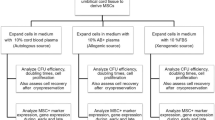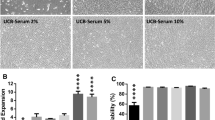Abstract
Human umbilical cord-derived mesenchymal stem cells (hUC-MSCs) hold great potential for their therapeutic use in various clinical diseases. Many publications have reported on human blood-derived alternatives to animal serum for culturing mesenchymal stem cells, such as human serum, allogenic umbilical cord blood serum, and human platelet derivatives. However, it is not clear whether human umbilical cord blood plasma (UCBP), as the surplusage of umbilical cord blood mesenchymal stem cell extraction, could be used. In this study, in order to make the best of umbilical cord blood, the human UCBP was dialyzed to replace fetal bovine serum (FBS) in the culture medium. hUC-MSCs were cultured in the new medium. Cell growth rate, specific biomarkers, and differentiation properties were detected to characterize the cell proliferation and MSC-specific properties. The hUC-MSCs cultured in such derived medium were verified with proliferation rate, cluster differentiation markers, cell cycle, as well as differentiation capabilities. Such dialyzed human UCBP is fully comparable with, if not superior to, FBS in deriving and culturing hUC-MSCs.






Similar content being viewed by others
References
Amit M.; Shariki C.; Margulets V.; Itskovitz-Eldor J. Feeder layer- and serum-free culture of human embryonic stem cells. Biol. Reprod. 70: 837–845; 2004.
Bossolasco P.; Cova L.; Calzarossa C.; Rimoldi S. G.; Borsotti C.; Deliliers G. L.; Silani V.; Soligo D.; Polli E. Neuro-glial differentiation of human bone marrow stem cells in vitro. Exp. Neurol. 193: 312–325; 2005.
Ding D. C.; Shyu W. C.; Chiang M. F.; Lin S. Z.; Chang Y. C.; Wang H. J.; Su C. Y.; Li H. Enhancement of neuroplasticity through up regulation of beta1-integrin in human umbilical cord-derived stromal cell implanted stroke model. Neurobiol. Dis. 27: 339–353; 2007.
Dominici M.; Le Blanc K.; Mueller I.; Slaper-Cortenbach I.; Marini F.; Krause D.; Deans R.; Keating A.; Prockop D. J.; Horwitz E. Minimal criteria for defining multipotent mesenchymal stromal cells. The International Society for Cellular Therapy position statement. Cytotherapy 8: 315–317; 2006.
Grove J. E.; Bruscia E.; Krause D. S. Plasticity of bone marrow-derived stem cells. Stem Cells 22: 487–500; 2004.
Jung J.; Moon N.; Ahn J. Y.; Oh E. J.; Kim M.; Cho C. S.; Shin J. C.; Oh I. H. Mesenchymal stromal cells expanded in human allogenic cord blood serum display higher self-renewal and enhanced osteogenic potential. Stem Cells Dev. 18: 559–571; 2009.
Karahuseyinoglu S.; Kocaefe C.; Balci D.; Erdemli E.; Can A. Functional structure of adipocytes differentiated from human umbilical cord stroma derived stem cells. Stem Cells 26: 682–691; 2008.
Leonard P.-K. A.; Do T. P.; Thein Z. M.; Hasan Mahmud R.; Tan X.-W.; Yap C.; Tan D. T. H.; Beuerman R. W. Ex vivo expansion of conjunctival and limbal epithelial cells using cord blood serum-supplemented culture medium. Investig. Ophthalmol. Vis. Sci. 52(9): 6138–6147; 2011.
Ma K.; Fox L.; Shi G.; Shen J.; Liu Q.; Pappas J. D.; Cheng J.; Qu T. Generation of neural stem cell-like cells from bone marrow-derived human mesenchymal stem cells. Neurol. Res. 33: 1083–1093; 2011.
Mareschi K.; Novara M.; Rustichelli D.; Ferrero I.; Guido D.; Carbone E.; Medico E.; Madon E.; Vercelli A.; Fagioli F. Neural differentiation of human mesenchymal stem cells: evidence for expression of neural markers and eag K+ channel types. Exp. Hematol. 34: 1563–1572; 2006.
Peng J.; Wang Y.; Zhang L.; Zhao B.; Zhao Z.; Chen J.; Guo Q.; Liu S.; Sui X.; Xu W.; Lu S. Human umbilical cord Wharton's jelly-derived mesenchymal stem cells differentiate into a Schwann-cell phenotype and promote neurite outgrowth in vitro. Brain Res. Bull. 84: 235–243; 2011.
Pereira W. C.; Khushnooma I.; Madkaikar M.; Ghosh K. Reproducible methodology for the isolation of mesenchymal stem cells from human umbilical cord and its potential for cardiomyocyte generation. J. Tissue Eng. Regen. Med. 2: 394–399; 2008.
Ramasamy R.; Tong C. K.; Yip W. K.; Vellasamy S.; Tan B. C.; Seow H. F. Basic fibroblast growth factor modulates cell cycle of human umbilical cord-derived mesenchymal stem cells. Cell Prolif. 45: 132–139; 2012.
Sankaranarayanan K, T C, G GP, V M, U P, Renny CM, Raghavan U, R SB, Guhathakurta S, M CK (2011) Humanised substitutes for animal sera in human mesenchymal stem cell culture and differentiation. Cell Biol. Int. doi:10.1042/CBI20100649.
Shetty P.; Bharucha K.; Tanavde V. Human umbilical cord blood serum can replace fetal bovine serum in the culture of mesenchymal stem cells. Cell Biol. Int. 31: 293–298; 2007.
Spees J. L.; Gregory C. A.; Singh H.; Tucker H. A.; Peister A.; Lynch P. J.; Hsu S. C.; Smith J.; Prockop D. J. Internalized antigens must be removed to prepare hypoimmunogenic mesenchymal stem cells for cell and gene therapy. Mol. Ther. 9: 747–756; 2004.
Tekkatte C.; Gunasingh G. P.; Cherian K. M.; Sankaranarayanan K. “Humanized” stem cell culture techniques: the animal serum controversy. Stem Cells Int. 2011: 504723; 2011.
Wang Q.; Mou X.; Cao H.; Meng Q.; Ma Y.; Han P.; Jiang J.; Zhang H.; Ma Y. A novel xeno-free and feeder-cell-free system for human pluripotent stem cell culture. Protein Cell; 2011. doi:10.1007/s13238-012-2002-0.
Wu K. H.; Zhou B.; Lu S. H.; Feng B.; Yang S. G.; Du W. T.; Gu D. S.; Han Z. C.; Liu Y. L. In vitro and in vivo differentiation of human umbilical cord derived stem cells into endothelial cells. J. Cell. Biochem. 100: 608–616; 2007.
Yang C. C.; Shih Y. H.; Ko M. H.; Hsu S. Y.; Cheng H.; Fu Y. S. Transplantation of human umbilical mesenchymal stem cells from Wharton's jelly after complete transection of the rat spinal cord. PLoS One 3: e3336; 2008.
Acknowledgments
This study was funded by the National Natural Science Foundation of China (81070614), National Science and Technology Plan 973 of China (2009CB930201), and science and technical development project of Guangxi Chuang autonomous region (0993003A).
Author information
Authors and Affiliations
Corresponding authors
Additional information
Editor: T. Okamoto
Rights and permissions
About this article
Cite this article
Ding, Y., Yang, H., Feng, J.B. et al. Human umbilical cord-derived MSC culture: the replacement of animal sera with human cord blood plasma. In Vitro Cell.Dev.Biol.-Animal 49, 771–777 (2013). https://doi.org/10.1007/s11626-013-9663-8
Received:
Accepted:
Published:
Issue Date:
DOI: https://doi.org/10.1007/s11626-013-9663-8




